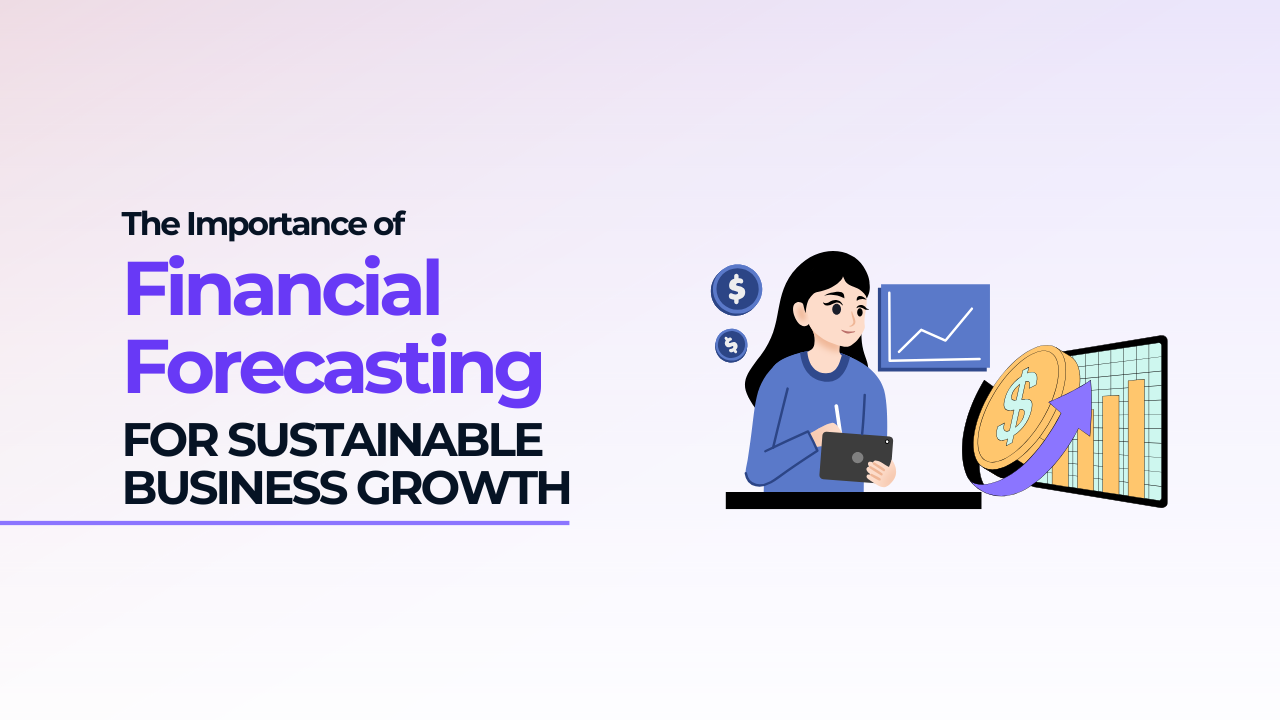
The Importance of Financial Forecasting for Sustainable Business Growth
The Importance of Financial Forecasting for Sustainable Business Growth
Financial forecasting is more than crunching numbers. It is a forward-looking discipline that allows businesses to anticipate change and plan confidently. Whether you are leading a new startup or managing an established company, the ability to project future outcomes influences how stable and sustainable your growth can be.
By turning financial data into strategy, forecasting helps leaders allocate resources wisely, prepare for uncertainty, and make informed decisions that strengthen profitability and long-term performance.
What Is Financial Forecasting and Why It Matters
Financial forecasting is the process of estimating future financial performance using past data, current trends, and expected market movements. It allows companies to project revenues, expenses, and cash flow with the goal of improving financial decision-making.
Without forecasting, businesses rely on reaction rather than preparation. This can lead to overspending during strong months or cutting back too severely when sales slow down. Forecasting transforms uncertainty into direction, allowing leaders to plan with clarity.
A consistent forecasting process also builds confidence in business planning. It provides a roadmap that aligns financial goals with operational realities and ensures resources are used strategically.
The Role of Financial Forecasting in Business Planning
Business plans define goals, but forecasting provides the structure to reach them. A strong forecast links ambition to numbers, setting measurable targets that can be tracked and refined over time.
For example, if your business aims to grow sales by 20 percent next year, a forecast helps you determine what budget, staffing, and marketing efforts are needed to support that growth.
Integrating forecasting into business planning makes your strategies more realistic and actionable. It connects vision with execution and replaces assumptions with evidence-based direction.
Types of Financial Forecasting Every Business Should Know
Different time frames require different types of forecasts. Each one supports specific decision-making needs:
- Short-Term Forecasting: Focuses on a year or less, helping manage cash flow, payroll, and daily operations.
- Medium-Term Forecasting: Spans one to three years and supports planning for growth, new hires, and resource expansion.
- Long-Term Forecasting: Looks three to five years ahead, guiding investment, innovation, and sustainability strategies.
When these forecasts are used together, they give a full picture of both short-term priorities and long-term potential.
The Connection Between Financial Forecasting and Cash Flow
Cash flow keeps your business alive, and financial forecasting helps keep it balanced. By predicting both inflows and outflows, you can prepare for upcoming challenges and opportunities.
For example, a financial forecast may show a potential cash shortage two months from now. Knowing this early allows you to adjust spending, secure financing, or accelerate collections before it becomes a problem. This proactive approach keeps your operations smooth and your business financially healthy.
In essence, financial forecasting gives you control over cash flow, ensuring that financial surprises are minimized and business growth remains consistent.
Managing Risk Through Financial Forecasting
Uncertainty is unavoidable, but forecasting allows you to prepare for it. By modeling various outcomes, companies can anticipate how factors such as inflation, market shifts, or supplier changes will impact results.
Scenario planning makes forecasting especially powerful. You can test “what if” situations—such as a 10 percent price increase or a temporary sales drop—and create solutions in advance. This builds flexibility and strengthens financial stability even during unpredictable times.
Forecasting transforms risk into preparedness. It replaces fear of the unknown with strategic confidence.
Building Investor Confidence and Accessing Capital
Investors, lenders, and partners look for financial clarity before committing to support a business. Forecasting provides that clarity.
A detailed financial projection shows not only where the company stands but where it is headed. It signals responsibility, awareness, and vision—qualities investors value. When forecasts are accurate and transparent, they increase credibility and make it easier to secure funding for new projects or expansions.
Consistent, well-documented forecasting reflects a business that understands its path and inspires trust among stakeholders.
Financial Forecasting as a Decision-Making Tool
From hiring employees to expanding into new markets, every decision carries financial implications. Financial forecasting allows leaders to compare options and choose the one that offers the greatest return with the least risk.
Before making large investments or operational changes, forecasts reveal whether your business can sustain them. This insight prevents overspending, poor timing, and misaligned priorities.
Rather than making decisions based on instinct, financial forecasting helps you act with confidence and clarity, supported by data.
Aligning Financial Forecasting With Business Goals
Forecasting should evolve alongside your organization. As markets shift and new priorities arise, your financial projections must adapt.
An effective forecast reflects not only numbers but also purpose. It aligns financial health with company mission, ensuring that progress is sustainable and measurable. Regularly updating forecasts keeps teams accountable and decisions consistent with long-term objectives.
When used properly, forecasting becomes a living system—one that grows with the business rather than being a one-time report.
Technology’s Role in Financial Forecasting
Modern tools have made forecasting more accurate and efficient. Platforms like QuickBooks, Microsoft Power BI, and cloud-based analytics applications simplify the process of collecting data and identifying trends.
Artificial intelligence further enhances forecasting accuracy. Machine learning can detect subtle market shifts, customer behavior patterns, or seasonal fluctuations that traditional methods might miss.
Technology does not replace human judgment, but it enhances it. Combining software analytics with professional insight results in faster, more reliable forecasts that help businesses make decisions with confidence.
External Resource: Learn more about forecasting methods on Investopedia’s Financial Forecasting Guide.
Overcoming Common Challenges in Financial Forecasting
Even the best financial forecasting efforts face challenges. Common obstacles include outdated data, unrealistic assumptions, or changing economic conditions. These issues can be overcome with a structured approach.
To strengthen your financial forecasting, follow these best practices:
- Keep accurate and updated accounting records.
- Review and update forecasts regularly.
- Use modern tools for data tracking and analysis.
- Work with financial professionals like ENLOGIQ to refine projections and validate results.
A structured and consistent approach transforms forecasting into a dependable business system that improves decision-making across departments.
Financial Forecasting and Sustainable Growth
Sustainability in business means more than being profitable—it means maintaining balance. Forecasting helps ensure that growth does not outpace resources or stability.
By planning reinvestments, managing debt, and timing expansion carefully, you maintain financial health while continuing to grow. This discipline allows your company to scale responsibly and remain adaptable even in changing market conditions.
Financially sustainable growth comes from preparation, not chance. Forecasting is the foundation that keeps progress steady and intentional.
How ENLOGIQ Helps Businesses Master Financial Forecasting
Not every business owner has a background in finance, and that is completely fine. At ENLOGIQ, we simplify financial forecasting by turning complex data into clear strategies.
Our process includes:
- Reviewing historical performance and market trends
- Building revenue and expense projections
- Developing multiple financial forecasting models
- Integrating forecasts into your broader business strategy
We make financial forecasting straightforward, practical, and scalable so leaders can focus on growth while maintaining confidence in their finances.
Read our article on Social Media Marketing Tactics to Enhance Brand Visibility to understand how strong marketing and financial forecasting work hand in hand to boost business performance.
Practical Steps to Build a Reliable Financial Forecast
To begin developing a reliable forecast, focus on consistency and structure.
- Collect Historical Data: Review your past financial performance to identify patterns.
- Identify Key Drivers: Recognize which elements, such as pricing or labor costs, have the greatest effect on revenue.
- Select a Forecasting Method: Use quantitative models based on numbers or qualitative models based on experience.
- Develop Scenarios: Build best-case, expected, and conservative versions of your forecast.
- Review and Update Frequently: Adjust based on new data or changing goals.
- Integrate With Strategy: Ensure every forecast supports your broader business objectives.
Following these steps helps transform financial data into a meaningful management tool that guides both short-term actions and long-term planning.
The Long-Term Benefits of Financial Forecasting
Businesses that forecast regularly experience greater stability and agility. The practice strengthens financial control and helps leaders make informed, confident decisions.
The long-term benefits include:
- More accurate resource management
- Improved cash flow planning
- Better visibility into business performance
- Increased trust from investors and lenders
- Reduced exposure to financial risk
- Continuous, sustainable progress
Forecasting provides the knowledge needed to anticipate challenges before they arise. It helps companies respond quickly to change and grow from a position of strength.
Forecast the Future, Secure Your Growth
The economy is changing faster than ever, and businesses that stay prepared are the ones that stay ahead. Financial forecasting helps you turn information into insight so you can lead with clarity instead of reacting to uncertainty.
It is not about predicting the future perfectly but about understanding where your business is headed and preparing accordingly. Companies that make financial forecasting a regular practice gain a clear advantage because they operate with direction, confidence, and control.
Ready to strengthen your financial foundation?
Contact ENLOGIQ to explore how forecasting can support smarter, more sustainable business growth.
Follow ENLOGIQ on Instagram or connect with us on LinkedIn to learn how smart financial forecasting can transform your business decisions, strengthen your strategy, and drive long-term success.
Subscribe to our newsletter
Lorem ipsum dolor sit amet, consectetur adipiscing elit. Suspendisse varius enim in eros elementum tristique.
By clicking Sign Up you're confirming that you agree with our Terms and Conditions.
Recommended posts
Lorem ipsum dolor sit amet, consectetur adipiscing elit. Lorem ipsum dolor sit amet, consectetur adipiscing elit.

Ready to grow your business?
Partner with us to develop tailored strategies and practical solutions that drive growth, improve efficiency, and set your business up for lasting success.
Schedule a Call